Inspiration and ideas For every bathroom floor plan
Planning a perfect bathroom for everyone requires you to consider a wide variety of demands. What sounds simple and logical in theory often comes with enormous obstacles in practice. Take, for example, the different requirements of a family bathroom, a barrier-free bathroom, a wellness bathroom, or a very small bathroom. What all types have in common is that the shape and size of the bathroom layout that defines the space is decisive when planning.
Why is the bathroom floor plan decisive for planning?
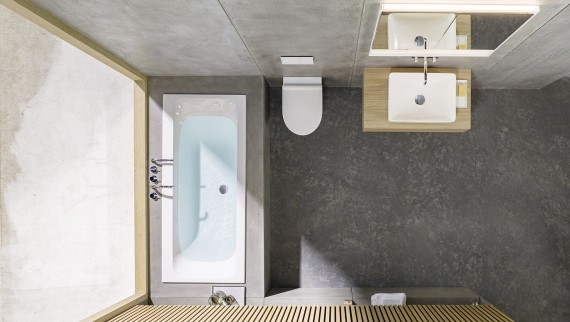
The floor plan of the bathroom sets the framework for planning. This applies not only to aesthetic aspects that are important for well-being, but in particular to functional aspects as well:
- How can the sanitary appliances such as bathtub, shower, washbasin, and toilet be arranged?
- How can the layout allow sufficient freedom of movement between the appliances?
- And how can the bathroom designer provide sufficient storage space in the bathroom?
Once these questions are answered, there are practically no obstacles to using the bathroom to its full potential.
Common bathroom layouts and their possibilities
A dream bathroom for everyone! This would be simple – if only there were enough space. Examples of homes in glossy magazines often have unparalleled amounts of space. In reality, however, the situation is usually much different. Either the plans have already been drawn up or the bathroom layout is set in stone. With this in mind, a few scenarios and the possibilities for different floor plan sizes can be found below.
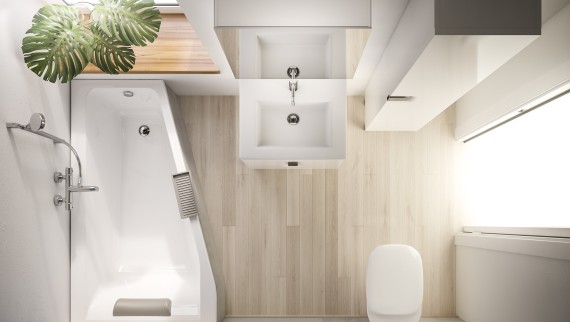
20 to 65 sq. ft. – optimal use of small bathroom layouts
The more limited the space on offer, the less design freedom. This applies to a bathroom with a floor plan of 40 sq. ft. with shower, for example. A clever room design is particularly important here and should be based on stripping back the functional elements to the bare minimum. For example, it helps to position plumbing essentials like the toilet and sink trap behind the wall. Combining this with a space-saving washbasin cabinet also allows for additional storage space.
In small bathrooms, ceramic fixtures – such as the washbasin and toilet – should be as narrow as possible.
Additionally, the tile size should also be considered in bathrooms with small layouts: large tiles are a better option here. With less grouting, the wall structure is more uniform, and the bathroom appears larger. Light, warm colors and optimal lighting also play a role here – particularly in bathrooms without windows.
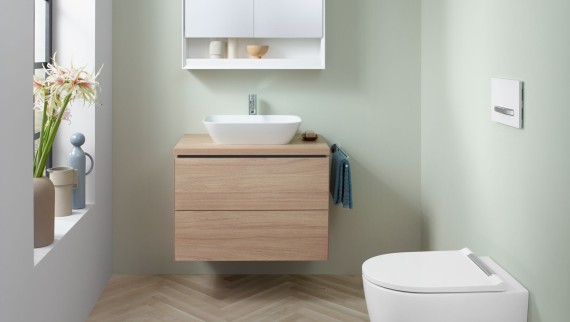
Ideas for narrow bathrooms
For bathrooms with narrow layouts, the same requirements apply as for small bathrooms. If a bathtub is required, it is recommended to use the width of the room. In this case, a room width of at least 60 inches – the length of a standard bathtub – is needed.
When positioning the toilet, it should ideally avoid a direct view of the door – thus ensuring optimal privacy.
Medium-sized bathrooms offer freedom of movement
Medium-sized bathrooms have an area of around 75 to 200 sq. ft. In contrast to small bathrooms, the question here is not whether a shower or bathtub should be installed, but instead whether there is enough space for both sanitary appliances. Whatever the decision, the space to move has to be taken into account in medium-sized bathrooms. This relates to the distances between the sanitary installations, the distance to the wall, or the free space available in front of a washbasin or toilet. What is important here is that the space to move on the individual appliances does not overlap. In terms of layout, a differentiation is made between two fundamental principles – a design with the sanitary appliances along the wall, or a completely open-plan design. However, the position of the supply ducts may be decisive and must also be taken into account when positioning the sanitary appliances.
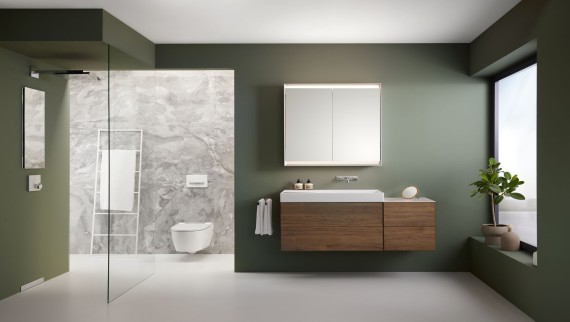
200 sq. ft. and more – a range of options for large bathrooms
Anyone with a bathroom measuring at least 200 sq. ft. can design their dream bathroom. The sky’s the limit when it comes to the design possibilities here.
Even a sauna can be considered. Or what about a freestanding bathtub positioned in such a way that it offers a view through the panoramic windows?
Using the space available to the full is certainly the best way of creating your own personal oasis of well-being.
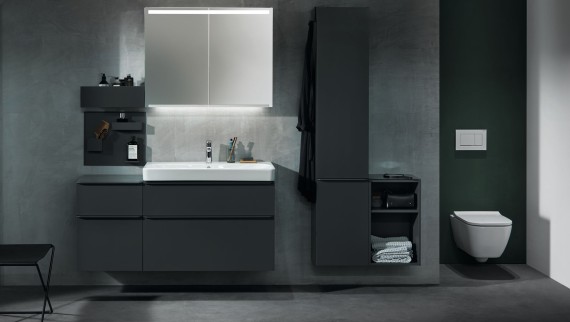
Unusual floor plans in the bathroom – using corners and niches correctly
Corners and niches can help enhance the bathroom in a variety of ways. Depending on the niche size, the installation of a shower or toilet is the obvious solution. This uses the available space optimally and automatically creates a natural sense of privacy.
Niches are also a perfect option as storage space and can be equipped with shelf units or surfaces. They can also be used for displaying accessories or decorative elements.
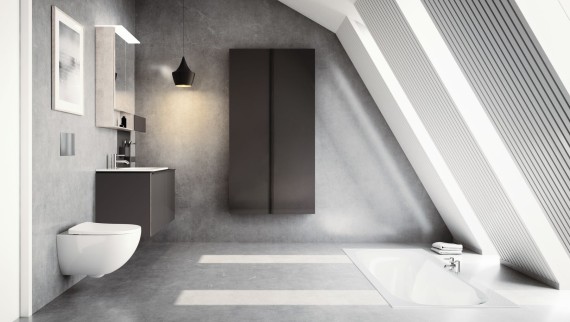
Tips for bathrooms in the attic
If you are planning a bathroom in a space with roof pitch, then several special reference values have to be observed.
The pitch of the roof should be at least 35° for a bathroom, while the room height required by a person to be able to stand upright is set at 6-1/2 feet minimum. This should be taken into account when installing a shower in particular. If a bathtub is planned instead, it is recommended to check the load-bearing capacity of the floor due to the weight of the tub when full.
Moreover, installing moisture-resistant wall cladding and sealing the floor against moisture are essential steps before installing a washbasin and toilet.


